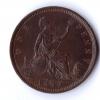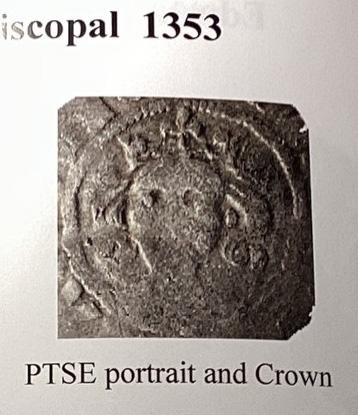-
Posts
1,801 -
Joined
-
Last visited
-
Days Won
110
Content Type
Profiles
Forums
Events
Downloads
Store
Gallery
Articles
Everything posted by jelida
-
I suspect so, and while close I don’t think it’s an actual die match with H’s. Potentially a very rare coin, especially as the one illustrated is the best Dave Greenhalgh could find! Jerry
-
-
That very distinctive ‘stalked’ central fleur looks pretty much identical to the illustration of the ‘Edward III Pre Treaty Series E York Episcopal’ Penny on page 70 of ‘The Galata Guide to Mediaeval Pennies Part 1’ though I cannot see a quatrefoil after ‘ANGLIE’ on H’s specimen. It is an interesting coin, and I think Dave Greenhalgh is the man to give an opinion here, if anyone is a contact. Jerry
-
I think you are there or thereabouts. There is definitely an inner circle both sides, and a CIVITAS LONDON reverse. The obverse Iegend is probably EDWARDVS REX but there is too little face/crown detail to be much more specific - certainly North class 10 or later, and likely Edward II. The North classification has been substantially re-written and subdivided in the Withers (Galata) publications which are highly recommended. Jerry
- 4 replies
-
- 1
-

-
- identification
- farthing
-
(and 1 more)
Tagged with:
-
I agree, it’s either die wear or very possibly the power of the strike, a reduced impact affecting the metal flow into the recesses of the die. Other detail such as the rocks and the lines on Britannia’s shield also seems reduced. I really don’t know who’s given her the finger though. Jerry
-
Hello Jaybob, if you type the description from the slab into a ‘search engine’ - one called ‘Google’ is good- and press ‘search’, you may be able to answer your question yourself and you will find that the sense of achievement is far greater than asking someone else to do it for you. Otherwise, the answer is ‘yes’. Jerry
- 1 reply
-
- 1
-

-
Well the mintmark (above the ‘C’ of CIVITAS ) looks as though it might be a cross pattee, or at least the leg of an expanding cross. This would rule out Richard III, but it could still be Edward IV, Henry V etc- though I haven’t looked into further detail. Jerry
-

Issues on Richard's penny website
jelida replied to Paddy's topic in Forum technical help and support
Just make sure that you have it all safely stored, I and many others would pay good money if it was available as a download or cd. Jerry -
Looks like a Charles II shilling to me. S 3322? Jerry
-
Just soak it in acetone, won’t do any harm. Jerry
-
I really don’t see any hint of delamination, just a die flaw and the adherent plastic residue. It really is a very decent coin. Jerry
-
Agree- dab, don’t rub, with cotton wool and acetone. Jerry
-

London Coins and Live Bidding
jelida replied to VickySilver's topic in British Coin Related Discussions & Enquiries
At least two of the Victorian pennies are mis-identified, including the F28 I think, so do check the photos, not the text. Jerry -
It is nice, and very comparable with the Noonans example in the last month or so, which hammered at £140, so about £200 all in. https://www.numisbids.com/sale/9497/lot/184 I should possibly have gone for that. Jerry
-
On its way to Herefordshire, Stu, I thought it was underpriced too. Jerry
-

Collectible Great Britain Gold and Silver - Super Deal
jelida replied to Geordie582's topic in Items For Sale
Ah yes, I remember now! 😄 Interestingly, being raised in very rural Welsh Cardiganshire, the locals pronounced us ‘Dah-viss ’ , to differentiate us from the ubiquitous’ Day-vees’ of about a third of the remaining population. Jerry -

Collectible Great Britain Gold and Silver - Super Deal
jelida replied to Geordie582's topic in Items For Sale
Hi Geordie582, nice to hear from you after all these years, indeed since 2016. And I note from your Omnicoin profile that you are 95 on the 5th, so Happy Birthday for two days time. I also infer that time had been rather unkind to you since you seem to have adopted American language idiosyncrasies and started using the dollar and cryptocurrency, Cumbria must have changed alarmingly since my last visit and our mutual love of good old £sd! The Trump effect, I presume - 52nd state? You have to be so wary of anything you read nowadays. However thank you for your generous offer but I have just agreed to send most of my money to some African lawyers who are processing an inheritance of millions of dollars from an apparent late friend of my late mother whose name I cannot pronounce, so bit skint at the mo. Good luck with your sale, Jerry -
2 and 3 both appear to have trifoliate crowns and read CIVITAS CANTOR for Canterbury on the reverse, both Edward I. Difficult to be sure about 4, lacking detail, may be bifoliate and is of London, probably Edward II . Number 1 has me stumped, no access to books at the moment, reverse legend seems to start with a Lombardic ‘N’ , ‘NAM’ or RAM’ and ends with an ‘S’. Could it be a continental imitation of Edward III? Thats as much as I can offer while grandchild sitting. Jerry
-
Very common - in fact ‘normal’ on obverse 6 pennies in better condition, must have been present on at least one master die. It was likely featured on a ‘C’ punch used in die preparation, size /depth a little variable with the strike. Jerry
-
Also die fill, the recesses fill with grease, metal powder etc over time during the minting process and don’t fill fully when striking the coin. Jerry
-
You would be well advised to attend a coin fair, such as those advertised in the back of Coin News. I go monthly to the Midland Coin Fair and have had many bargains as well as fairly priced offerings- but it does pay to know your subject, and don’t be afraid to take a reference book or target list. I have also done well on EBay over the years but again know your subject. Bronze and copper pennies are faked , but the usual Chinese offerings are fairly easy to spot to the trained eye. Look at the vendor’s feedbacks and if there are any complaints or they are new sellers steer clear. And I wouldn’t buy purported Celtic or Saxon coins on EBay without taking advice eg on this forum, as at any one time most are fakes. Jerry
-
Clever, Chris, though it took me a few minutes………….😀 Jerry
-
It could well be, though I am not sure that the rock to the lower left of the shield is present which would be diagnostic. Can you post both sides, these rare coins tend to have very few die pairings and digit spacing etc will help confirm the possibility? Jerry
-
I think that actually might be an F78, it has the narrower gap between the ribbons, the gap is wider on an F72. But one of the best that I’ve seen. Do you agree Richard? Jerry
-
Yes, it’s a ja. Is it F72 or F78? The F72 ja variety seems rare in the higher grades - most are plain obverse j. All the F78 are ja and it is a fairly scarce coin . Jerry



